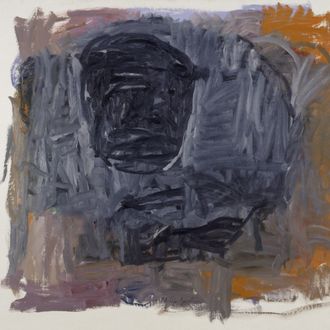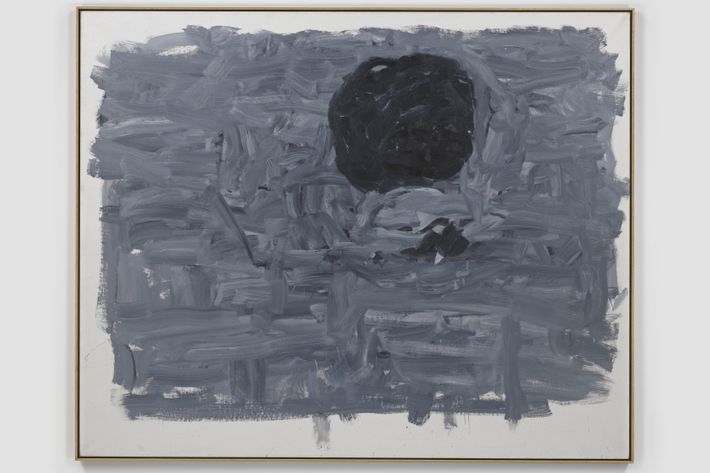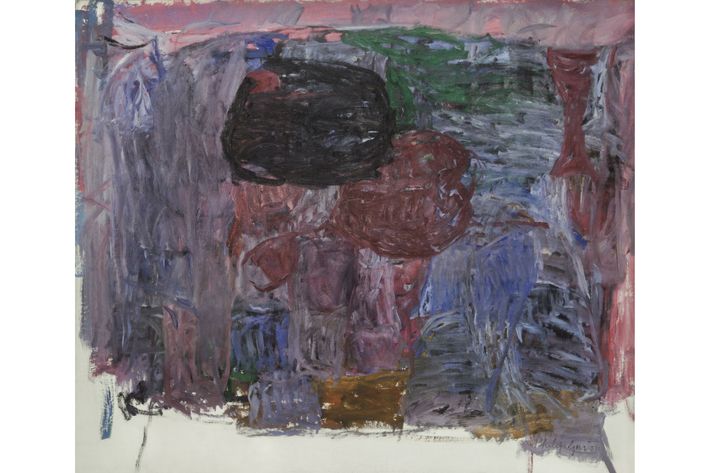
As late as he came to the style, by 1957 Philip Guston was a highly admired first-generation Abstract Expressionist — a phrase he hated. How “late” was Guston? In the 1940s peers like Arshile Gorky, Franz Kline, Jackson Pollock, and Mark Rothko were finding their ways into all-over abstraction. Yet Guston experimented with figures, grounds, solid spaces, and objects until 1950. Pollock — whom Guston went to high school with in Los Angeles (the two were expelled for designing satirical leaflets) and who urged Guston to move to New York in 1935 — had been making abstract paintings since 1939. Gorky had done so since 1932; Rothko and Willem de Kooning reached these further shores by the early 1940s. Guston didn’t go fully abstract until about 1950! History is lucky; had he waited a minute more the Ab Ex train would have left without him and we might never have heard of him.
Guston was always a hesitant plodder, and when he finally did get to real abstraction he stayed ambivalent about it. “Every real painter wants to be, and his greatest desire is to be, a realist,” he said. The abstract works that deservedly won him fame are beautiful shimmering lyrical fields of broken brush strokes, flickering grounds of pearly blue and pink, serene combinations of Monet and Turner with inflections of Mondrian’s early piers-reflected-in-water. But Guston started to feel as if he was only taking small bites. By the 1950s, he felt he “had nowhere to go.” Saying “I hope sometime to get to the point where I’ll have the courage to paint my face … to paint a single form in the middle of the canvas,” he started doing exactly that. And had the courage to do it at the apex of his career.
By 1970 he’d finished “clearing the decks.” From then until his death, in 1980, at 66,* Guston left abstraction behind and made some of the most memorable and influential paintings of the late 20th century, big and small: huge, gloppy, opaque-colored images of Ku Klux Klansmen driving around in convertibles, smoking cigars; cyclopes heads, in bed, staring at bare lightbulbs; piles of legs and shoes; figures hiding under blankets, clutching paintbrushes in bed. A lot of these are so narratively accessible they can seem almost comic-strip-like. But also cryptic. I see spiders, newts, malignant clouds, boatmen, snake charmers, lanterns lighting up existential nights. The list of artists influenced by this incredible work includes Nicole Eisenman, Amy Sillman, Albert Oehlen, Carroll Dunham, Elizabeth Murray, and Georg Baselitz, who saw as early as 1959 that Guston was involved with “a distortion of the abstract … full of concrete forms.” Jasper Johns saw that, too.
But the stakes of abandoning abstraction were high. Recognition had come late to Guston’s generation. The Abstract Expressionists had labored alone in America, dirt poor, with no audience, no art-world apparatus to support them. Only one another. As Barnett Newman famously put it, “We were making it out of ourselves.” And those selves were obsessed with going beyond Picasso and into non-objective painting. They had bet their entire lives on the gamble, which is why any sign of apostasy or disaffection was seen as a threat to all. Even after America took notice of the group, in the early 1950s, they were the constant butt of jokes about “my 3-year-old” being able to paint like that. Worse yet, no sooner had they arrived then a new group of artists — led by Jasper Johns and Robert Rauschenberg — arrived on the stage doing totally antithetical work. The world turned on a dime. In 1962, the Sidney Janis Gallery organized a show including Andy Warhol, Roy Lichtenstein, Wayne Thiebaud, and Claes Oldenburg. This was seen as a betrayal by Guston, Robert Motherwell, Rothko, and Adolph Gottlieb, who all quit the gallery in protest. It was the show in which de Kooning reportedly told Warhol he was “a killer of art.” But Guston wasn’t really in line with his colleagues; amidst all this he harbored secret feelings of wanting to change.
By 1957, he’d done everything he could do to avoid doing what he had to do, and his work began to solidify into something new. The lesson of his career is that in order to really be themselves all artists must find their inner Guston: an artist who foregoes easy answers, looks for and channels doubt and not knowing. An artist like this understands that he or she isn’t controlling their art — not really; that on some cosmic level art controls the artist. All great artists must be able to create a machine that can make things that they cannot predict. Even when they make what might be nightmarish or ugly to them.

Which is why “Philip Guston; Painter 1957–1967,” at Hauser & Wirth, a showcase of Guston at the turning point of his career, is an incantatory lesson for all artists. Perfectly curated by the gallery’s Paul Schimmel, the exhibition sounds a secret chord for artists in search of one of art’s many strange grails: how to make art that is original and entirely one’s own. This is especially pressing now that there are promising signs of artists everywhere trying to break through the fog of professionalism and careerism that have crept into the art world; the corporate carefulness that’s made too many painters make little moves in known directions; toe pre-approved formal lines; and make the system feel clogged up, static, sterile. Guston, who was desperate to change, knew this. He said “I got sick and tired of all that purity… the extreme codification of beliefs and the institutionalism of everything.” If that sounds painfully familiar, make it your business to see this show.
On view in the airplane-hangar-scaled museum-level gallery show are 35 paintings and 48 drawings. All are from this lesser-known decade of his career, 1957 to 1967. The entire group has not been exhibited together since the 1960s. So this is new information for many in the art world. What we see is a lead-up to what is perhaps the greatest last-act in 20th-century American art history: Guston’s all-hell-broken-loose id-under-pressure late figurative paintings.
The change comes slowly at first; Guston is always fighting it. As Jasper Johns put it about being an artist, “If you avoid everything you can avoid, then you do what you can’t avoid doing, and you do what is helpless, and unavoidable.” Guston did that. The opening gallery shows his first steps — so small you might not see them, thinking, Oh, he’s getting choppier, is all. I guess that triangle could be a hood or something. In 1957, Guston’s colors turn more opaque; warm tones turn frosty and muddy; odd, armlike shapes appear, torsos or trunks, hillocks, shadowy head configurations. But nothing definite. Being figurative was so strictly verboten that at one point Guston said he painted a can with paintbrushes in it, lost his nerve and scraped it off. It was just too much. In the next gallery, Guston’s backgrounds turn blocky. The shimmery thing is gone. So are the little snaky strokes. Things are thickening. A huge maroon hand thing emerges from the top of one canvas. Compositions get optically bolder. In Garden of M, named after his wife and daughter (both named Musa), we spot something like a patchy garden grid, or maybe two lumpy figures clutching each other in bed. Sooty grays, yellows, and crimsons abound. But things stay abstract. What’s happening is that Guston is looking for every way possible not to make a figurative painting. He couldn’t just paint that single thing inside a canvas, a head, or even a can, without retreating back into abstraction. It must have been hellish. These works are almost ugly.

Then, in 1963, he just blows through the fear. A big, black-hat-wearing, egg-shaped head appears with a shaky arm holding what might be a paintbrush and maybe a small canvas. This wasn’t Ab Ex, it wasn’t Pop, it wasn’t like anything. The title Painter III tells us what’s going on; it’s a self-portrait and a collective portrait of all artists’ immense inner temperaments when venturing into realms unknown. But it’s too much for Guston and he pulls back. Again. Looking is just a smooshed figure that might be gazing at a black rectangle. It’s almost self-as-grub. This one-step-forward, one-step-back crab dance continues as Guston looks for biomorphic, architectural, or geometric solutions rather than what’s staring him in the face: the horror of going both figurative and expressionistic. In the last work in the show, Guston hits the wall of all the implied image-making. An all-gray field that is so confusing to Guston he doesn’t even go to the edges, leaving swaths of canvas unpainted. In the middle of this is what looks like a black sun hovering — as if everything that Guston can empty out has been emptied out: except the truth. The implication of figure, ground, narrative, image. He’d reached Johns’s “helpless” place.
Guston must have known the return to figuration couldn’t be denied any more. And still he refused. He was in a battle of wills with his art. It must have been nightmarish. So much so that he stopped painting altogether for three years after the last canvas in this show. He didn’t show his work again until 1970. Critics had slammed that work as “displeasingly raw”; the canvases were said to have “unpleasant texture.” His colleagues were shocked, suspicious, and thought he was trying to hop on the Pop bandwagon; one painter friend asked why he had “to go and ruin everything.” Lee Krasner was said to find the work “embarrassing.” New York Times critic Hilton Kramer lambasted Guston as “a mandarin pretending to be a stumblebum,” dismissing the work as “cartoon anecdotage … funky, clumsy and demotic,” and concluding “We are asked to take seriously his new persona as an urban primitive … and this is asking too much.” But the die was cast. While Pollock was the first to truly break through to pure non-objective painting, it was Guston who was the first to break out. And yet nobody seemed to understand. He’d risked everything and lost.
But Guston had crossed the Rubicon and was becoming the great painter of the American night. Not the night that follows day; the night of self. He said he wasn’t painting “pictures” but “one’s experiences and one’s enlargement of self.” Guston moved the sublime — the bigness of it all — away from abstraction where the Abstract Expressionists located it, away from nature where the 19th century placed it, off the ceilings of churches where it went in the Renaissance, and back, finally, to where it really is and probably has always been since it left the fires in the caves: The sublime is in us! To see that pictured brings Emerson’s “alienated majesty” back to us. Guston helped push everything aside, all the classicizing, romanticizing, philosophizing, or being a theologian of the sublime. This is epic. And it’s in all of Guston’s late work. Of his contemporaries, only the always generous de Kooning saw the real, deep content of Guston’s late art. He said that the subject of this art is “freedom.”
*The original version of this article incorrectly stated that Guston died at age 76. He was 66.
*This article appears in the May 30, 2016 issue of New York Magazine.

